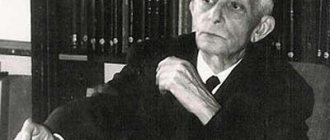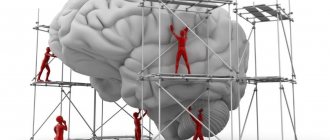The founder of Gestalt therapy, Frederick Perls, believed that there was no need to delve into memories and look for the causes of today's problems. Problems must be solved “here and now”. Interpretations of the causes of the disorder are of little use. It's better to fix them. In Gestalt therapy, the emphasis is on practice. A person must learn to solve his problems himself. Perls called the client’s independent work “experiments.” Here are some of them.
What would our body be worth if nature did not have protective mechanisms built into it? A trivial cut would never heal; the lightest breeze would cause a severe runny nose, putting us not to bed for three days, but to a completely different place and forever. But the cut heals, and a walk in windy weather does not end with a cold. At different levels, starting from the smallest cell, we are protected by nature from diseases and disorders.
In the same way, our psyche tries to correct mental problems on its own, without always informing us about it. This fully applies to worries, anxiety, and fears. The load on all systems of the body is so great that the psyche cannot stand aside and offers its own solutions to the problem, without waiting for our own attempts and the intervention of specialists.
Nature protects us with the fanaticism of a wasp, carrying food to the larvae walled up in honeycombs. At the same time, our defenses hide our problem from us. So analgin, dulling pain, promotes the development of an abscess. Our condition and behavior have long been outside the norm, but it seems to us that everything is fine.
The founder of Gestalt therapy, Frederick Perls, believed that there was no need to delve into childhood memories and look for the causes of today's problems. Problems must be solved “here and now.” The sources of many disorders are interrupted and unfinished actions, unsatisfied desires. A person can discover fragments of them in himself here and now, complete everything unfinished and move on.
Interpretations of the causes of the disorder are of little use. It's better to fix them. In Gestalt therapy, the emphasis is on practice. Moreover, self-use of various methods is encouraged. The client must learn to solve his problems himself, and not run with them to a psychotherapist. Perls called the client’s independent work “experiments.” Here are some of them.
Technique one: resolving internal conflict
This conflict is that our impulses, desires and aspirations, suppressed by the requirements of norms of behavior, return to us and are suppressed by us. One part of us strives to realize the forbidden, the other suppresses it.
We experience the same thing at the bodily level: some muscles make involuntary contractions to realize a forbidden desire; the antagonist muscles hold them back and tense. Our body and soul are all in blocks and clamps. We will remove them if we allow the forbidden to be realized in one form or another, the blocked to break out. The interrupted action will be completed, you can rest and move on.
The point of the reception is to do what you want. Allow your body to realize hidden desires. Release inner aggression. Don't let her turn against you. Find expression for internal conflict, express it and thus avoid self-destruction.
Do not press your palms on your eyes. Crush the orange and release your aggression in this action.
Give your briefcase a kick.
Punch the sofa.
If your body is holding back from flailing from side to side and saying “No!” - do it - dangle and talk.
Do you say “no” firmly and loudly? Or is your voice shaking? Are you asking or making excuses? Or is your “No” suppressed rebellion and disobedience? Who are you resisting, who are you fighting off?
Give vent to all the kicks, punches and screams of childish rage.
Listen to your muscle sensations and you will feel a strong desire to perform a certain movement. For example, stretch.
Stretch. Continue this movement. Stretch your hands if they stretch. Who are they drawn to? Or maybe they are pushing away?
Perform all movements with the strength corresponding to your feeling.
By doing all this, you discharge the suppressed impulse, connect the divided parts of your personality, get rid of the consequences of internal conflict, in which fear and anxiety are always present.
Who is suitable for Gestalt therapy?
Therapy solves the problems of healthy people or people with a neurotic organization, and has a good effect in cases of difficulties caused by interaction with other people, misunderstandings, negative feelings, and grievances. That is, therapy will not bring relief to patients with severe mental disorders.
Such unpleasant and dangerous emotions as fear, anxiety, aggression, loss of meaning in life, loneliness, excessive anxiety, insomnia, apathy and frequent bad mood are also reasons to visit a Gestalt therapist.
The method is suitable for working with teenagers, adults, and married couples. Women open up more easily during consultations than men, who are accustomed to being guided by reason and easily ignore their desires in order to achieve a goal or success, and a thorough analysis of feelings often seems to them an unnecessary exaggeration.
Method two: chew and swallow
It is also based on the idea of the unity of the physical and mental in man.
In this case, on the identity of the absorption of food and information (moral demands, theories, ideas, concepts). The baby's transition from sucking and swallowing liquid food to biting and chewing solid food determines too much in a person's future life. Regulation of the first natural attempts at aggressive influence on the environment (solid food must be bitten off, chewed, in order to then digest and build your body from it), force-feeding “through I don’t want to” (until you eat everything, you won’t leave the table!) leads to that the vital process of eating becomes something hasty and disgusting. The pieces are swallowed whole and settle like stones in the stomach. A natural attempt at rejection (vomiting) is strictly suppressed. The child is deprived of freedom in choosing food, suppresses natural and positive aggression in this act and also suppresses his aversion to what is imposed.
Needs are not being met. Riot is punishable. In the end, aggression finds its way out either by turning on oneself or by projecting it outward.
The same thing happens in information, consumption of knowledge, moral norms and requirements. Here, freedom of choice, attempts to “bite off, chew and swallow,” the desire to critically master the same norms of behavior in order to consciously and independently construct one’s own ideas after “digesting” them, are suppressed quite harshly. This is done by authoritarian parents, educators and teachers.
As a result, knowledge lies in us like a dead weight. Standards of behavior and requirements accepted entirely without analysis and digestion become a source of internal conflict.
Force feeding, forced education, forced upbringing. Food doesn't fill you up. Sometimes it poisons. Moral demands, accepted in their entirety and not assimilated, put pressure and become the cause of frustration, internal and interpersonal conflicts, uncontrollable aggression, which always reflects fear and anxiety.
In the methods proposed below, we will restore our natural need for biting, chewing and assimilation of food, physical and spiritual. We will restore the ability to reject the undigested and undigested. We will learn to reject unlearned norms in order to rework, accept and assimilate them.
Concept of Gestalt therapy
In various difficult life situations, we can lose contact with ourselves, stop tracking our emotions and desires to please others. Often this happens due to unfinished stories or unlived feelings. A course of Gestalt therapy helps to rediscover oneself, identify true feelings and thoughts, teaches one to cope with problems independently and achieve what one wants.
Fritz Perls, the luminary of German psychiatry, is considered the founder of therapy. In the 1940s, he became seriously interested in Gestalt psychology, studying the human psyche’s desire for complete completion of any relationship, image or situation. Translated from German, Gestalt means “image”.
Later, scientists discovered that the human brain actually recognizes holistic, complete images more easily. For example, if a person sees with his eyes an unfinished drawing made up of scattered or interrupted parts, then his subconscious will still see solid figures.
Gestalt in psychology is an unfinished situation that puts negative pressure on a person. That is, even if the relationship between two people has physically ended, the unspoken thoughts and emotions experienced by one of the participants in the broken couple during the process can negatively affect his psyche and quality of life.
It would seem, what would be easier, to satisfy an existing need, to realize emotions, to relieve tension? But often we do not realize the root cause of our problem, we do not know how or do not allow ourselves to show feelings due to internal prohibitions, rules, and attitudes.
2.1. Try to focus on food at least once a day
Give up the usual socialization (essentially distraction) while eating - reading, watching TV, socializing.
The dog that grabs the bone tries to get privacy with it. At this moment, nothing is more important for her than gnawing, chewing, swallowing.
For the sake of experiment, become a dog for half an hour.
Pay attention to how you do this. Learn to eat. We warn you: you won’t learn it right away - it will take two months, no less.
Monitor your feelings, inhibitions and resistances.
How soon do you stop tasting what you eat? Does loss of taste coincide with bouts of thinking and inner talking?
Are you able to bite (do you tear off a piece of, for example, a roll with your teeth, or clench your teeth and tear the bread from the piece clenched by your teeth with your hand?)
What do you experience when you eat - impatience, greed, disgust, the desire to stop it all as soon as possible?
If you don’t like the food - it’s bland, tasteless - do you refuse to eat or swallow it in a hurry, not paying attention to the taste and smell?
The answers to these questions contain answers to how you would naturally eat, as well as the opportunity to return to active processing and assimilation of food, to that method and action that was once interrupted and suppressed.
What methods does a Gestalt therapist use in his work?
During psychotherapeutic sessions, the client is encouraged to share sincere emotions with the psychologist, answer questions and receive feedback.
Psychologists in the Gestalt approach use the following methods:
- working with feelings;
- exercises and tests to express your state through body movements;
- analysis of dreams and memories;
- creating and playing out situations and sensations with the participation of fictional characters.
According to the principle of Gestalt therapy, the main conditions for a happy life are the completion of unfinished business and the client’s awareness of his desires and actions, therefore, in the first stages of work, the therapist tries to lead the patient precisely to the moment of understanding his problem and the reasons that caused it, and at the end of therapy, to teach him take full responsibility for your decisions and actions in order to be able to independently correct difficult moments in your future life and live through events to the end.
Our course will help you master the technique of the Gestalt approach - in just 4 months, experienced teachers will tell you about all existing methods of Gestalt therapy, and after passing the final certification, you will receive a diploma of the established form and will be able to work as a consulting psychologist yourself.
2.2. Pay attention to your jaws
When you're not chewing, are they relaxed or locked in a death grip?
If you walk all the time, clenching your teeth and playing with your nodules, this indicates fixation on the act of sucking - a hallmark of a neurotic. The normal transition from sucking to biting and chewing in a person with a bulldog grip has been interrupted. He won’t let go of the piece, but he can’t even bite it off. His aggression in life is limited to clenching his jaw. He is not able to break off outdated relationships; he sees only possible failure in risk. Lives with outdated habits, memories and old discontents.
Clutched teeth also lead to tension in the throat and chest, obstruction of breathing and, as a result, the development of anxiety.
You need to get rid of the fixation by working with your jaws.
Experiment with your teeth. Let the top and bottom barely touch. Do not squeeze or unclench them for a while. Watch what happens.
Soon your teeth will begin to chatter as if from the cold. The trembling will spread to the muscles. You will begin to shake. Don't suppress this trembling. It should embrace you completely.
Now walk your teeth. Change their contact: upper incisors, lower molars and vice versa. Massage your nodules while doing this. Find the painful points here and focus on them, simultaneously releasing all the clamps that are now noticeable to you until the tension completely stops.
Now clench your jaws as if you were biting. Feel how your gums, mouth, throat, and eyes tighten after them. Focus on this tension and then suddenly release your jaws.
We explain with simple examples
If the unfinished action is some simple everyday story, you can easily deal with it yourself - find, buy, fix and move on with your life in peace. But when it comes to relationships, things are worse. Such an incomplete gestalt will be accompanied by a range of negative feelings - resentment, anger, fear, anxiety, sadness and even grief - which, at best, will lead to chronic discomfort, and at worst, to illness and suffering.
Let's look at a simple example.
Ivan is already an adult, he can’t establish relationships with his elderly parents, all attempts to have a heart-to-heart talk end in mutual claims and resentments, tea parties end in quarrels, evenings end in slamming doors. Ivan is angry, but he cannot stop communicating with his parents. Together with a psychologist, they are trying to understand this situation. The specialist is interested in what specific emotions these clashes evoke in Ivan, what feelings arise in him when he calls or visits his mother and father. At first, Ivan admits that this is anger, but in the course of subsequent psychological conversations it turns out that there are other conflicting feelings, that since childhood he has been expecting support and approval from his parents, but at the same time he still feels like a schoolboy whom his mother and father ask questions about. : “4 for the test? Why not 5? I tried hard..." “Schoolboy Ivan” gets offended, the thought comes that he is bad, a loser, incompetent, if his parents do not praise him. The task of the psychologist in this case will be, with the help of Gestalt therapy, to return our hero to his significance, to help him again feel pride in his successes, regardless of the parental reaction.
More examples of common open gestalts:
- Due to lack of attention and dislike from parents in childhood, an adult will intensely seek and demand from his partner manifestations of love and attention that he lacked in childhood. Will such relationships be harmonious where there is constant pressure?
- A love union that breaks up, for example, on the initiative of a man, can cause a woman to constantly relive the breakup, trying to determine the cause and the guilty party, simultaneously proving to her former lover that everything is fine with her, and life has only gotten better without him. With such a psychological state, a happy relationship is unlikely for this woman.
All these examples indicate that the situation has not been lived through to the end and has not been mentally released. That is, the gestalt is not completed and will continue to cause suffering to the person. The well-known saying “Time heals” will not work here; qualified help from a specialist is needed.
2.3. This exercise will help solve completely different problems through biting and chewing.
You are restless, angry, depressed, constantly blaming someone or having exhausting internal anxious conversations and battles with an imaginary offender.
Try to vent your inner aggression in... biting and chewing.
Take an apple or a piece of stale bread. Bite, gnaw, tear with your teeth as impatiently and aggressively as you want.
Do not swallow in chunks.
Chew, chew, chew, chew.
Your aggression is no longer directed at you or others. It is realized in the most natural biological way - in biting and chewing.
How can a Gestalt therapy specialist help?
The duration of therapy in each case is different - for some, in 2-3 sessions they will be able to cope with a harmful situation and improve their psycho-emotional state, while for others, even a few months will not be enough.
During therapy, the psychologist:
- will help you understand what exactly causes you anxiety and negativity;
- will reveal your feelings and sensations associated with the root cause;
- with the help of special psychotherapeutic techniques, it will help complete the gestalt and teach you how to act in similar cases in the future.
Exercises
Individual or group sessions with a Gestalt therapist allow you to step by step “expose” the emotional “trash” in the client’s subconscious, bring them to awareness of the problematic situation, teach them to express themselves according to their inner impulses and live in harmony with their body.
At the beginning of therapy, exercises are used to focus feelings and reflect them, then techniques for releasing negative emotions are used. The doctor provides general guidance to the process of gestalt formation; he focuses patients’ attention on problematic issues, encouraging awareness of the need to freely express their emotions.
Examples of exercises:
1. "Hot chair." The client sits in the center of the group (at trainings, participants usually sit in a circle) and is asked to talk about what worries him. After a dialogue with the patient on the “hot chair”, the trainer asks to express the feelings and sensations of other participants. They all must be in the center of the circle.
2. Awareness. Here patients talk about feelings and thoughts in the present moment.
3. Increased bodily manifestations during exercise. The therapist asks the training participants to exaggerate any non-verbal gestures, for example, turning finger tapping into a “drum roll”.
4. Shuttle movement. Injecting the background into the figure. If the client reports loneliness, the therapist tries to “color” the background as negatively as possible, i.e. focuses on bodily manifestations (trembling, squeezing hands or feet, etc.).
5. "Empty chair." In this exercise, on a chair in the center, patients conduct a dialogue not with a real person, but with an imaginary person, a dead person, or themselves.
6. Making circles. All members of the group speak to each other in a circle.
Reviews
Patient Maria:
I attended group classes for about a month. There I met people who had similar problems to me. At first it was strange to give way to feelings, but gradually I realized that with emotions the negativity goes away. I began to allow myself much more in real life, learned to rejoice like a child and live in harmony with myself.
Patient Olga:
I didn’t quite believe that practical psychology could save me from tightness and constraint. But it was thanks to Gestalt therapy that I was able to love myself and do what I had long wanted. I understood the difference between my desires and the standards of behavior imposed on me. It’s such freedom to act according to your feelings and not hide them!
Patient Alena:
I became “comfortable” with myself, my anxiety and stiffness went away. I am calmer than ever, cheerful and value myself.
Patient Vladimir:
It was a very strange experience for me. I realized that the feelings that are inside me are much more “voluminous” and richer than their external manifestations. I stopped being embarrassed by them and started talking about them to my wife. We became much closer, it turns out she always really wanted me to tell her about love. My life has really changed - it has become brighter!
Patient Marina:
I'm glad I went through therapy. Only then did I realize that those around me, with their manipulations, almost turned me into a neurotic. The realization that I could live my life and emotions did not come immediately, but this path returned my health, both mental and physical.










